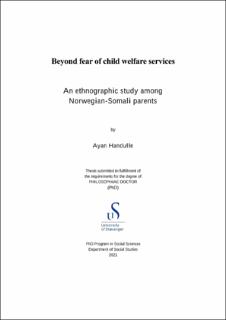| dc.contributor.advisor | Vassenden, Anders | |
| dc.contributor.advisor | Enoksen, Elisabeth | |
| dc.contributor.author | Handulle, Ayan | |
| dc.date.accessioned | 2022-02-14T09:56:28Z | |
| dc.date.available | 2022-02-14T09:56:28Z | |
| dc.date.issued | 2022-03 | |
| dc.identifier.citation | Beyond fear of child welfare services : An ethnographic study among Norwegian-Somali parents by Ayan Handulle, Stavanger : University of Stavanger, 2021 (PhD thesis UiS, no. 623) | en_US |
| dc.identifier.isbn | 978-82-8439-055-0 | |
| dc.identifier.issn | 1890-1387 | |
| dc.identifier.uri | https://hdl.handle.net/11250/2978682 | |
| dc.description.abstract | In many countries, migrants and ethnic minorities express fear of child welfare service (CWS). This is reflected in Norwegian research and media, where fear and mistrust surround the debate on migrants’ relationship with the agency. This thesis explores Norwegian Somalis’ fears of the Norwegian CWS in the context of their situation in Norway and their social world. While the relationship between the Norwegian CWS and several migrant groups is strained, we know little about how fears are constructed and perpetuated within migrant communities. Throughout my dissertation, I emphasise that migrants’ relations to CWS –whether fear factors into it or not – must be understood in light ofprocesses and dynamics far beyond CWS. We must pay attention to tight-knit ethnic communities, social networks, marginalised positions and transnational relations. My inquiry is guided by two core questions: How is the fear of CWS constructed among Norwegian-Somali parents, and how does the fear of CWS impact their everyday lives?
These questions were explored through nine months of ethnography, seven months in Oslo and two months in Somalia among returnees from Norway. Fieldwork consisted of, inter alia, observations in cafés and shops, participation in seminars and mosques, participant observation in a transnational school in Somalia, informal conversations, formally organised focus groups and in-depth interviews with parents.
The three articles comprising the empirical part of the dissertation cover the following topics. The first article explores how CWS fears among Norwegian-Somali parents are embedded in social networks and transmitted via stories of child removals. This paper provides extensive insight into the construction and perpetuation of fear. The analysis suggests a particular social process underlying Somali parents’ fears, which we coin ABCD, pertaining to (a) their socioeconomic adversities; (b)coping through bonding social capital; (c) children as a “lifeline”;and (d) (disproportionate) diffusion of child removal stories. The results demonstrate the importance of child removal stories that are transmitted through tight-knit social networks as well as why and how these stories spread.
Paper 2 is about how second-generation Somali parents portray middle-class identity when interacting with school and kindergarten personnel to avoid racial scrutiny and referrals to CWS. The paper examines how CWS scepticism and fear extend far beyond direct interactions between caseworkers and clients. We show how scepticism and fear influence parents’ encounters with institutions like schools and kindergartens, as these are institutions that have the power and obligation to potentially report to CWS.
The third paper addresses Norwegian-Somali returnees’ struggle for a sense of belonging in Norway and their worries regarding their children’s future. It highlights the complexity of being a marginalised migrant in Norway and the consequences thereof. I show that parents utilise temporary return as a tool to strengthen their dual belonging to both Somalia and Norway by reconstituting belonging to both countries through parenting in Somalia. The results reveal that parents cultivate and reproduce Norwegian cultural repertoires when in Somalia in order to maintain a belonging to Norway and to prepare for their future return to Norway, while concurrently encouraging their children to be proud of their Somaliness.
In sum, the findings from my thesis imply that Somali parents’ fears of CWS are drawn not only from their perceptions of that single institution but also from their experiences as Somali parents in Norwegian society as a whole. I therefore argue that, if we are to understand CWS fears among migrant parents in general and Somali parents in particular, we must adopt a broader approach that understands parents’ everyday lives and whether and how their experiences relate to socioeconomic marginalisation, racism, coping and networking. I also argue that, to understand CWS fears, we need a bottom-up methodological approach. The in-depth ethnographic account of the Norwegian Somalis’ CWS fears, investigated bottom-up, remains this study’s main contribution. | en_US |
| dc.language.iso | eng | en_US |
| dc.publisher | University of Stavanger, Norway | en_US |
| dc.relation.ispartofseries | PhD thesis UiS; | |
| dc.relation.ispartofseries | ;623 | |
| dc.relation.haspart | Paper 1: Handulle, A., Vassenden, A. “Disadvantaged Parents’ Fears of Child Protective Services: Transmission of Child Removal Stories Among Norwegian-Somalis”. (Manuscript). This paper is not included in Brage due to copyright. | |
| dc.relation.haspart | Paper 2: Handulle, A., Vassenden, A. (2020) “‘The Art of Kindergarten Drop-Off’: How Young Norwegian-Somali Parents Perform Ethnicity to Avoid Reports to Child Welfare Services. European Journal of Social Work, 24(3), 469-480. DOI:10.1080/13691457.2020.1713053 | |
| dc.relation.haspart | Paper 3: Handulle, A. (2021) Little Norway in Somalia: Understanding Complex Belongings of Transnational Somali Families. Nordic Journal of Migration Research, DOI: 10.33134/njmr.371. | |
| dc.rights | Copyright the author | |
| dc.subject | sosialt arbeid | en_US |
| dc.subject | somaliere i Norge | en_US |
| dc.subject | barnevernet | en_US |
| dc.subject | frykt for barnevernet | en_US |
| dc.subject | etnografi | en_US |
| dc.subject | norsk-somaliere | en_US |
| dc.title | Beyond fear of child welfare services : An ethnographic study among Norwegian-Somali parents | en_US |
| dc.type | Doctoral thesis | en_US |
| dc.rights.holder | ©2021 Ayan Handulle | en_US |
| dc.subject.nsi | VDP::Samfunnsvitenskap: 200::Sosialt arbeid: 360 | en_US |
